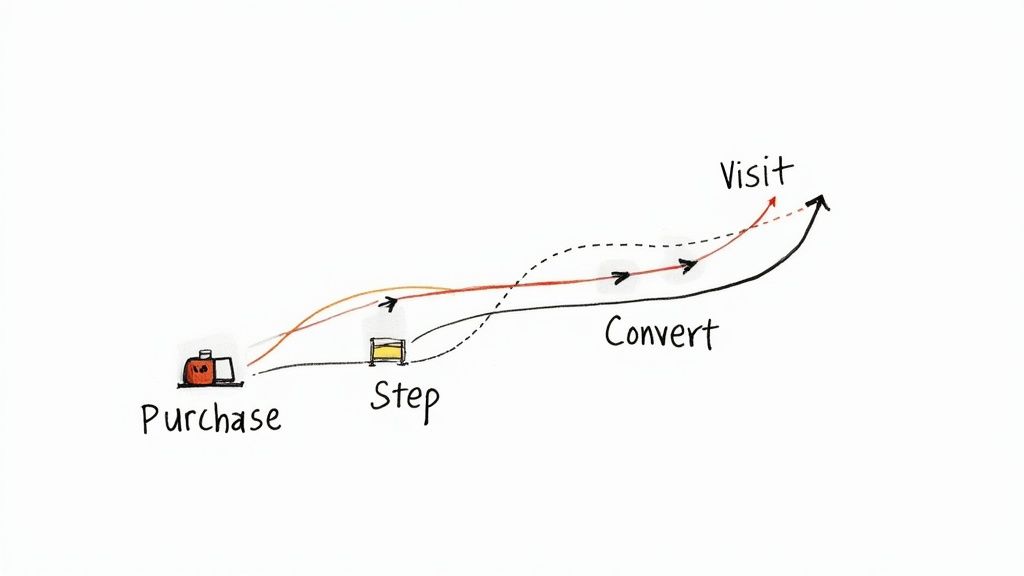How to Boost Conversions: Proven CRO Strategies
Understanding Website Conversion Fundamentals

Getting more visitors to take action on your website is essential for business growth. While attracting traffic is important, the real success comes from turning those visitors into customers and leads. To achieve this, you need to understand what makes people click, sign up, and buy.
Defining Key Metrics
The first step is knowing exactly what conversion means for your site. This could be completing a purchase, joining your email list, booking a demo, or any other specific action you want visitors to take. Your conversion rate shows how well you're doing at getting visitors to complete these actions. For instance, if your site gets 1000 visitors and 50 make a purchase, you have a 5% conversion rate.
Benchmarking and Industry Standards
To know if your conversion efforts are working, you need to compare your numbers against industry standards. This helps set realistic targets and shows where you can improve. Most websites see conversion rates between 2.35% and 5.31%. If you're in this range, you're on track - but there's always room to do better. Want to see how you stack up? Check out detailed conversion benchmarks here.
The Psychology of Conversion
People make decisions based on many factors when visiting your site. Everything from your page layout to your word choice can impact whether someone converts. Simple elements like clear buttons, customer reviews, and security badges build trust and encourage action. Time-limited offers and showing limited stock can also motivate visitors to act faster.
Common Conversion Pitfalls
Many site owners focus too much on making their site look pretty while forgetting about how easy it is to use. While good design matters, visitors care more about finding what they need quickly and easily. Another big mistake is not optimizing for mobile users. Since most people browse on phones and tablets today, your site must work perfectly on all devices. Keep these basics in mind as you work to improve your conversion rate and meet your business targets.
Mastering Traffic Quality and User Behavior Analysis

To boost your website's conversion rate, you need to understand who your visitors are and how they find you. Different traffic sources bring users with varying levels of interest and intent to convert. By analyzing these patterns, you can focus your efforts on attracting visitors most likely to take action.
Identifying High-Converting Traffic Segments
Some traffic sources consistently outperform others when it comes to conversions. Direct traffic - when users type your URL directly into their browser - often shows the strongest intent to engage. These visitors already know your brand and what they're looking for. Similarly, visitors who arrive through links on relevant industry websites tend to be more engaged with your content.
The numbers back this up: direct traffic converts at 3.3% on average, significantly higher than other sources. Some industries see even better results - healthcare, cosmetics, and legal services achieve 4.2% to 5.3% conversion rates from direct visitors. You can find more data in this detailed report: Conversion Rate Optimization Statistics.
Understanding User Journey Bottlenecks
Watching how users move through your site reveals valuable clues about what works and what doesn't. Heat maps and session recordings show exactly where visitors click, scroll, and give up. For example, if many people leave from the same page, that's a sign something isn't working - perhaps the navigation is confusing or the content doesn't match what they expected. Finding and fixing these issues helps more visitors complete their journey.
Optimizing for Different Devices and Platforms
Your visitors use many different devices to browse your site, and each group has unique needs. Mobile users often want quick answers and easy navigation with their thumbs. Desktop users might spend more time reading detailed content. Making sure your site works well on all devices - with responsive design and device-specific features - helps capture more conversions. When visitors have a smooth experience regardless of their device, they're more likely to become customers.
Unlocking Website Insights and Conversion Improvements
When it comes to boosting website conversions, having a solid data analysis strategy makes all the difference. While collecting metrics is important, it's how you analyze and apply those insights that truly drives results.
Selecting Essential Analytics Tools
Start with tools that give you actionable website insights. Google Analytics provides core data about traffic, behavior patterns, and conversion tracking. Specialized tools like heatmaps and session recordings can reveal how visitors interact with specific page elements. Choose analytics solutions that directly support your conversion targets.
Making Sense of Website Data
Instead of getting overwhelmed by metrics, focus on the numbers that matter most for your goals. If you want more email subscribers, pay attention to sign-up page performance metrics like:
- Landing page visits
- Form completion percentages
- Bounce rates on sign-up pages
Look for clear patterns - for example, if many visitors leave your subscription page quickly, you may need to improve the form design or clarify your value proposition.
Historical data analysis also plays a key role in conversion rate optimization. Track changes in traffic, rankings and user engagement over time using analytics tools to spot successful approaches and areas needing work. Learn more: Detailed historical data insights
Creating Clear Action Plans
Once you identify optimization opportunities, set specific, measurable goals tied to real business outcomes. Rather than a vague target like "get more conversions," aim for something concrete like "increase email sign-ups by 15% this quarter." This gives your team clear direction.
Building Your Optimization System
Develop a repeatable process for conversion improvements:
- Gather relevant data
- Analyze metrics and spot issues
- Test targeted changes
- Measure results
- Refine and repeat
This systematic approach helps you steadily enhance performance while adapting to shifting user needs.
Real-World Optimization Examples
Here are proven ways to apply data insights:
- Landing Page Tests: If bounce rates are high, try different layouts and copy to find what resonates
- CTA Improvements: Track click rates and experiment with button placement, text and design
- Personalization: Group visitors by behavior/demographics to deliver more relevant content
By turning data into strategic website improvements, you can systematically boost conversions while creating better user experiences. This leads to more sales and stronger customer relationships over time.
Building a Culture of Continuous Optimization

Getting better conversion rates takes ongoing effort and commitment. You need to make optimization a natural part of how your team works, not just a one-time project. Let's look at practical ways to build this mindset into your daily operations.
The Power of A/B Testing
A/B testing helps you make smart, data-driven decisions about your website. Instead of guessing what works best, you can test different versions and let the numbers guide you. For example, you might test if a simplified checkout process leads to more sales than your current setup. The results often surprise even experienced teams - simple changes can have big impacts. Recent studies show that A/B testing landing pages can boost conversions by 12%. Learn more about effective testing approaches in this guide: Conversion Rate Optimization 101.
Beyond Basic A/B Testing: Advanced Methodologies
Once you're comfortable with basic A/B tests, try multivariate testing to examine how different elements work together. This method lets you test multiple changes at once to find the best overall combination. Don't forget to gather real feedback too - user surveys and usability tests give you valuable insights that numbers alone can't show.
Prioritizing Tests and Measuring Long-Term Impact
Focus your testing efforts where they'll make the biggest difference. High-traffic pages and key conversion points should be your top priorities. But remember to think long-term - a change that boosts sales today might not be best for customer satisfaction and repeat business. Keep track of important metrics like customer lifetime value to understand the full impact of your changes.
Building a Sustainable Optimization Program
Make optimization part of your team's routine by creating clear processes. Set up a system to track tests, document what works (and what doesn't), and share findings across your organization. Use project management tools to keep everyone coordinated and moving forward. Review and update your approach regularly - what worked last year might need adjusting now. With consistent effort and learning, you'll steadily improve how well your website turns visitors into customers.
Using Social Proof to Boost Your Conversion Rate
When making purchases online, people naturally seek validation from others who have gone before them. This is why social proof has become essential for improving website conversion rates. By showing real experiences from actual customers, you can build genuine trust that motivates visitors to take action. Let's explore practical ways to use social proof effectively on your website.
Different Forms of Social Proof and How to Use Them
Here are the main types of social proof and how to apply them:
-
Customer Testimonials: Real quotes from satisfied customers work well on product and landing pages to address specific concerns and highlight benefits your customers care about.
-
Case Studies: Detailed success stories show exactly how your product helped solve a customer's problem. These work especially well for complex products or higher-priced services.
-
User-Generated Content (UGC): Photos, videos and reviews created by customers add authenticity. Display this content on product pages and social media to build trust naturally.
-
Expert Endorsements: Reviews from respected industry experts can boost credibility, particularly when launching new products or serving niche markets.
-
Social Media Activity: Live feeds showing positive social conversations about your brand create excitement and show active community engagement.
-
Trust Badges: Security certificates and endorsements from known organizations help customers feel safe doing business with you.
Placing Social Proof at Key Decision Points
Social proof works best when strategically placed throughout the customer journey. For example, testimonials on landing pages build initial trust, while product reviews near purchase buttons can convince hesitant buyers. Research shows the impact - websites using user-generated content see an average 3.2% conversion rate, which increases another 3.8% when visitors engage with that content. Learn more in these detailed conversion statistics.
Managing Your Social Proof Strategy
Make collecting positive customer experiences part of your regular process. Ask happy customers for testimonials, encourage reviews, and monitor social media discussions. Keep this content organized and easily accessible to use across your website. Track metrics like conversion rates and engagement to understand what resonates with your audience.
Keeping It Real and Following the Rules
While highlighting positive experiences is important, authenticity matters most. Never fake reviews or testimonials. Get proper permission to use customer content and follow advertising guidelines about endorsements. Being transparent builds lasting trust. Focus on sharing genuine customer stories and you'll see better conversion rates and more loyal customers over time.
Creating Your Conversion Optimization Roadmap

Let's take everything we've learned and build a practical plan to boost your website's conversion rate. This step-by-step roadmap will help you make steady improvements that drive real results.
Aligning Optimization With Business Objectives
Start by connecting your optimization work directly to your company's goals. If you're focused on growing sales, spend your time improving product pages and simplifying checkout. For B2B companies chasing leads, concentrate on landing pages and making forms easier to complete.
Prioritizing Optimization Efforts
Some changes will move the needle more than others. Look for the biggest opportunities first - like fixing a page where lots of visitors drop off. Test those changes before spending time on smaller tweaks. A good rule of thumb: focus on problems affecting the most visitors or the most valuable customer segments.
Resource Allocation for Optimization
Set aside dedicated time and budget for optimization work. You'll need people to run tests, tools to collect data, and resources to make improvements. Consider hiring specialists or training your team on A/B testing and analytics tools. Build optimization tasks into regular workflows so they don't get pushed aside.
Building Your Implementation Plan
Break down your optimization program into clear phases with specific goals. Create a schedule showing what you'll test, when you'll do it, and who's responsible. Use project management tools to track progress and keep everyone aligned. Regular check-ins help spot issues early.
Measurement and Tracking of Conversion Improvements
Pick the metrics that matter most for your goals. Track key numbers like:
- Conversion rate by page and source
- Bounce rates on key landing pages
- Average order value
- Time spent on site
Review these weekly or monthly to see what's working. Use the data to guide your next round of improvements.
Maintaining Optimization Momentum
Optimization is a continuous process of testing and refinement. Keep your team engaged by:
- Celebrating wins when tests succeed
- Learning from tests that don't work out
- Sharing results across departments
- Staying current with new testing methods
Scaling Your Optimization Program
As your site grows, your testing program should grow too. Document what works so you can repeat successful tests on new pages. Build systems to analyze data from multiple sources. Train new team members using your proven processes.
By following this roadmap and staying committed to ongoing improvements, you'll steadily increase conversions over time. Remember to regularly review and adjust your approach based on results.
Want a simple way to engage more visitors? Sitebot, an AI chatbot platform, can help you connect with visitors instantly and generate more leads automatically.


